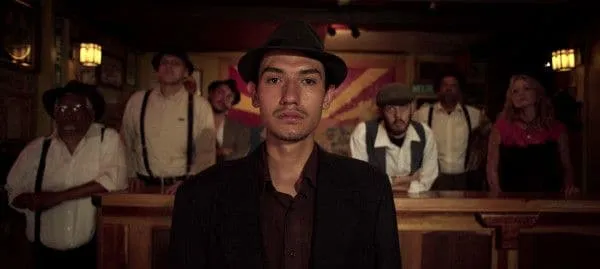Eye For Film >> Movies >> Bisbee '17 (2017) Film Review
Bisbee '17
Reviewed by: Owen Van Spall

Director Robert Greene’s previous documentaries have explored the uses of artifice to blur the fact/fiction line, such as in his docufictional ‘making of’ Kate Plays Christine, where we saw actors playing exaggerated versions of themselves researching real life people for a biopic. In his new film, Bisbee ’17, things are a little different, as Greene’s camera is recording, for the most part, someone else’s recreation of a 100-year-old historical event. But he also freely mixes into the recorded footage his own cinematic ‘takes’ on past events, creating a strange and maybe at times too self-self-conscious mass of layers to this study of one Arizona town’s dark past and how it reflects on America’s often troubled history of labour and race relations and the intersections between them. Still, though the film feels too smart and too busy for its own good at times, the story remains fascinating (though troubling), and the cinematography always striking.
The title of this doc refers to 1917: a troubled year in the mining town of Bisbee, where deep copper mines - the lifeblood the town and key to the war effort-remained for years in the purview of powerful mining companies. Their control over the main source of income for the town gave them huge power, not the kind of power that took kindly to organised labour when a major World War was going on.

On July 12, 1917, some 1,300 striking miners and their supporters — local citizens, immigrants from Mexico and Europe and many members of the Industrial Workers of the World (IWW) activist union (also called ‘Wobblers’) — were rounded up by a gang of some 2,000 deputised citizens under the eyes of the town sheriff and deported en masse from the town to Tres Hermanas, New Mexico. The charges were the dubious ones of ‘necessity’; that their strike demands posed a threat to the American way of life. Despite being dumped far from their camps and homes in a harsh desert, their fate was no longer the concern of the town. It remains a shocking story regardless of the audacious and complex approach taken by Greene to illuminate it, and one that cannot exist outside the discourse of the ‘build the wall’ rhetoric that rages around the wild Trump administration.
Greene actually gets most of the key facts over to you in an opening text crawl, and no one really disputes them. What he is really more interested in is how the locals have told, and continue to tell, the story and to justify it to themselves and others. Fascinatingly, Greene arrives in town when the locals are already deep into arranging their own re-enactment of the deportation to mark the centennial, and his camera travels around the various individuals and groups who are getting ready to take their ‘sides’ in the event; making era-appropriate costumes, staking out their viewpoints, and in many cases narrating their relationship to the participants who were involved back then.
Filmmakers like David Lynch have long made it a cliche that small, picturesque towns should be stuffed with secrets and odd folk wandering about, but Bisbee proves the cliche exists for a good reason; the townsfolk are a colourful and often eccentric bunch — from the conservative Ray family men, whose role on both sides of the re-enactment as both deputy and deportee will mirror how their family was bitterly divided back in 1917, to young cafe worker Fernando, whose Mexican heritage gives his role as a deportee extra charge and an experience that seems to really affect him. Various artists and historians, and a local radio host, have plenty to say too, often so stridently you wonder if there aren’t fights regularly breaking out over town about this issue.
Many descendants are surprisingly forthright in their defence of now-dead relatives who served as deputies or played some role in executing the deportations, while critical voices point to the difficulty certain townsfolk always have had in confronting the actions of one’s flesh and blood, as well as the how the long shadow the mining barons cast over the citizenry persists to this day. There is a strange fascination in watching the interviewee’s faces as they act out their roles when re-enactment day comes. What are they thinking? When does re-enactment stop and the person resume; particularly in the case where someone’s assigned ‘side’ aligns with their views on the deportation? Is it a positive sign that townsfolk with opposing views of the justness of the decoration are at least willing to come together for the purpose of seeing the re-enactment through, thus at least mutually acknowledging this chapter of Bisbee?
The town itself lends itself to cinematic framing too, and Greene’s DP has a field day not only lensing it in striking widescreen, as if a scene from a classic western is about to break into the narrative, but lets us savour some of the more eye-catching locations that are dotted about the town, such as the scarred earth and vast pits that marks the Dante’s Inferno that is the mining zone, a region surrounded by giant piles of excavated earth so dense that they have formed their own mountains. It is a shame then that the film rarely slows down to let us process all these voices, as Green often interrupts whatever point is being debated with one too many over-elaborate re-enactments, though these are undeniably well-shot in some memorably locations, including the re-opened mine (the company moved out in the 70s), an empty but gorgeously designed school, and what appears to be an ornate theatre built into the basement of a post office.
Reviewed on: 04 Nov 2018
















